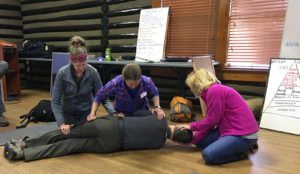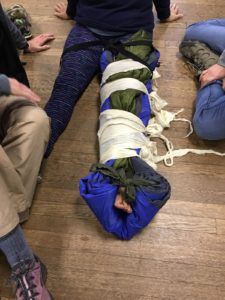by Natrieifia Miller
Why Wilderness First Aid Is Worth It
Disclaimer: This post is not intended as a substitute for the 16 hr Wilderness First Aid training and CPR/AED trainings facilitated by NOLS Wilderness Medicine Institute. It merely provides a brief overview of some of the main concepts as well as a summary of the author’s own impressions about taking the courses.
Before arriving at my CPR/AED training and the weekend ahead of wilderness first aid training, I steeled myself for a series of slideshow presentations, videos, and demos with a bit of hands-on practice sprinkled in. To my delight there wasn’t a powerpoint or procedural video to be watched. Instead, Phil Hart and Priscilla Hunt, our instructors from Landmark Learning, did a great job of engaging through sharing anecdotes and lesson information before providing live demonstrations that were quickly followed by some extended hands-on practice. It was a welcome surprise, and I feel more confident in my retention of the information because of it.

Bright and early the next morning we all met at the Island Ford Visitor Center for an even more information packed session, this time focusing on wilderness first aid. In the beginning I didn’t really think it would be too different from a regular first aid course. I expected it would be more in depth than anything I’d taken prior but I assumed the material would undoubtedly be similar. While there are similar principles, Phil pointed out the differences between urban first aid and wilderness first aid and why it matters for those of us volunteering or working in the outdoors. 
My favorite part of the whole program was getting to play out emergency scenarios. We were divided into groups of 3-4 people, with one person playing the injured party while the rest of the group would happen upon them “outside” and use skills we gained steadily throughout the course to help them as best we could. Usually the scenarios dealt with material we had recently covered, building on concepts we were becoming more practiced at applying. We had to think and react to deal with the discovery and treatment of specific injuries of our “patients.” In our last scenario of the course our instructors threw us a curveball. We happened upon a patient with persistent stomach cramps and after gaining as much information from our patient as possible, we each formed opinions on the cause of the ailment. Coming back to the class as a group we discussed what we thought caused the pain and gave evidence as to why. In the end we discovered there was no right answer because as rescuers, and in general, sometimes we just never discover the reasons why something is happening despite providing the best care within our abilities.

Overall, I was blown away by all of the hands on practice of our new skills and believe that wilderness first aid, as well as CPR/AED, trainings are a must for anyone spending a great deal of time outdoors. My training was made even more special by the great group of people I experienced it with and I’m so glad I received the opportunity.
Many thanks to the Georgia Appalachian Trail Club (GATC) who funded this training for their volunteers through a 2016 Georgia A.T. license plate grant and welcomed me to participate beside them as well. And thank you to Priscilla Hunt and Phil Hart for being such fantastic instructors, sharing your funny anecdotes, and providing useful feedback throughout the whole course!





